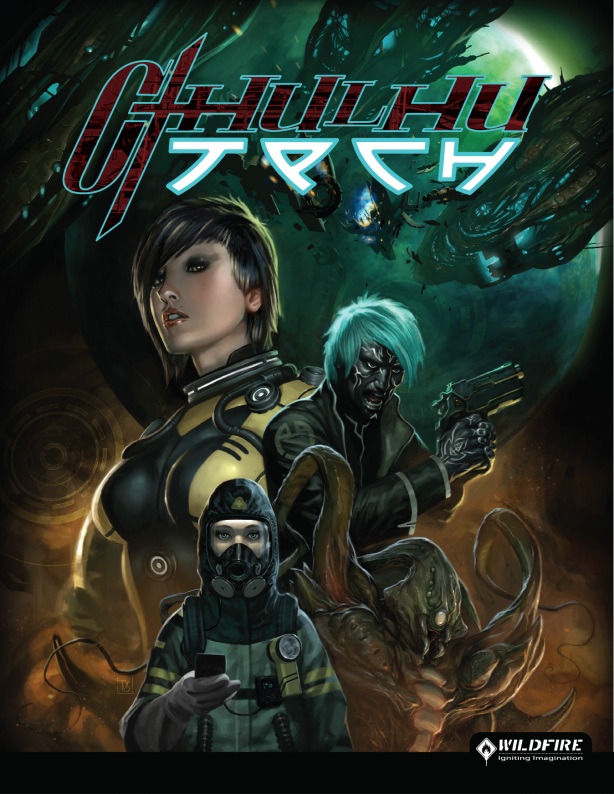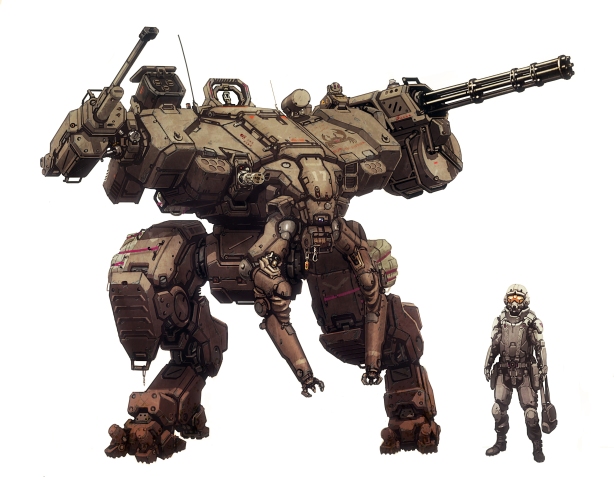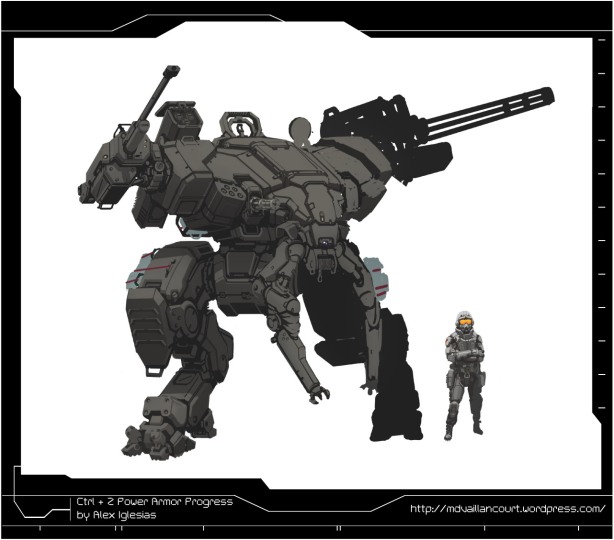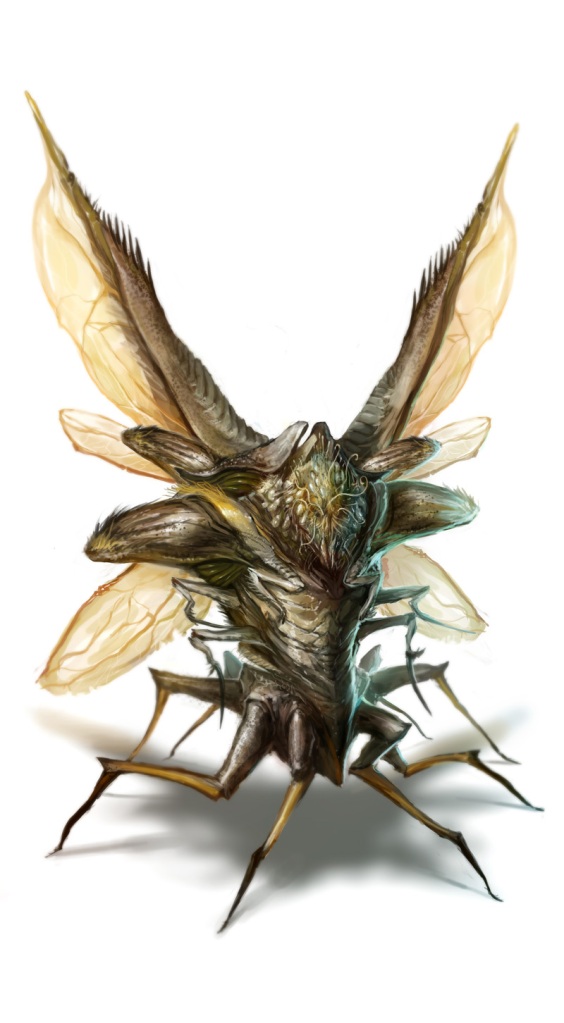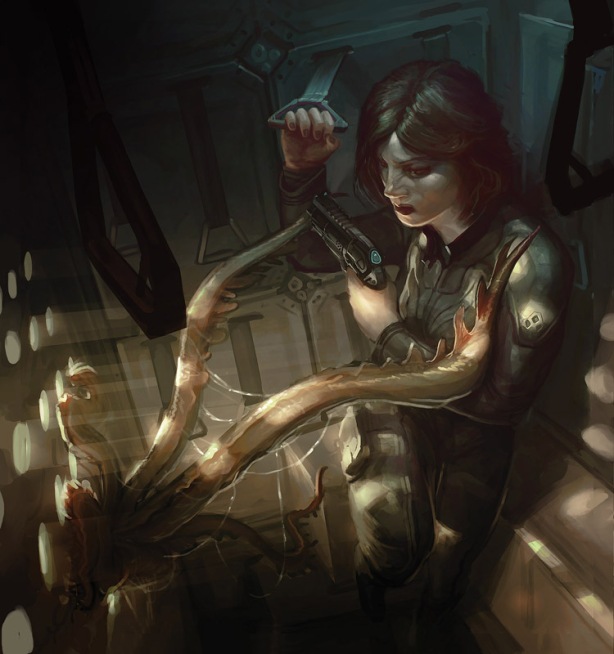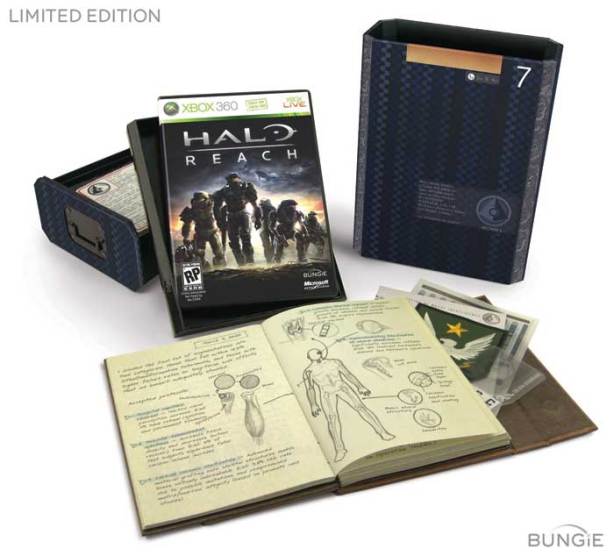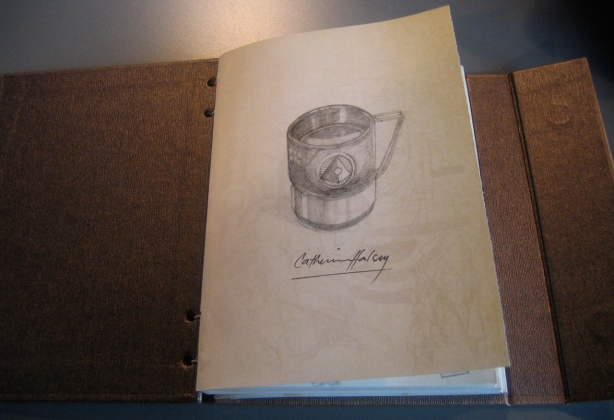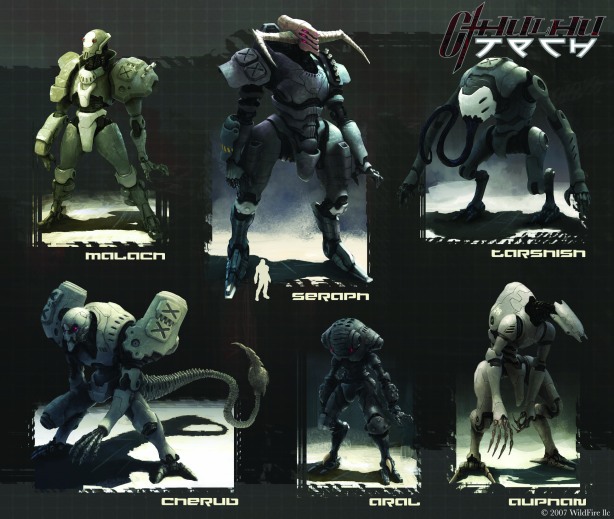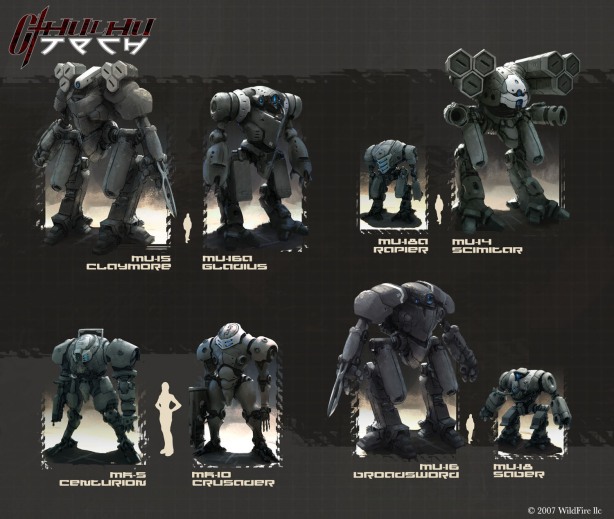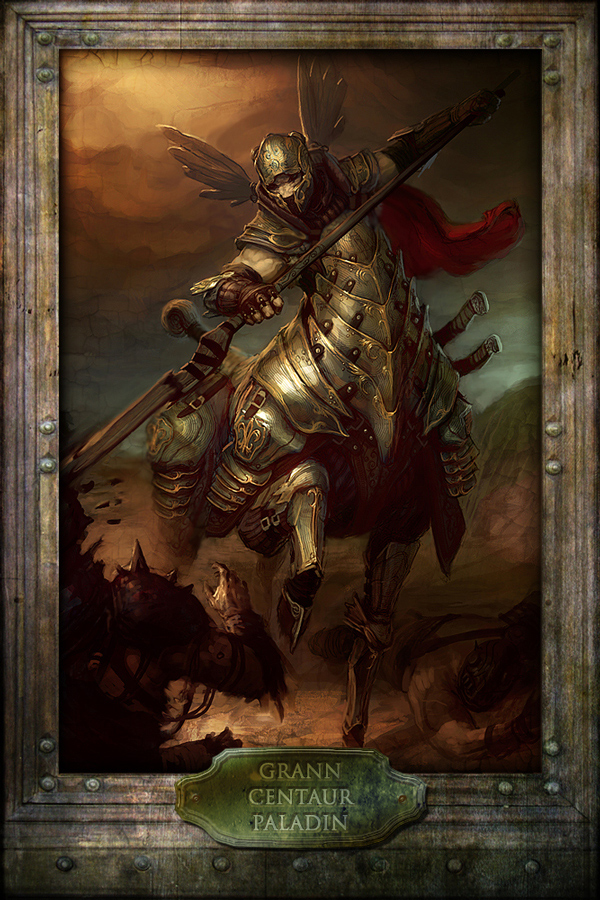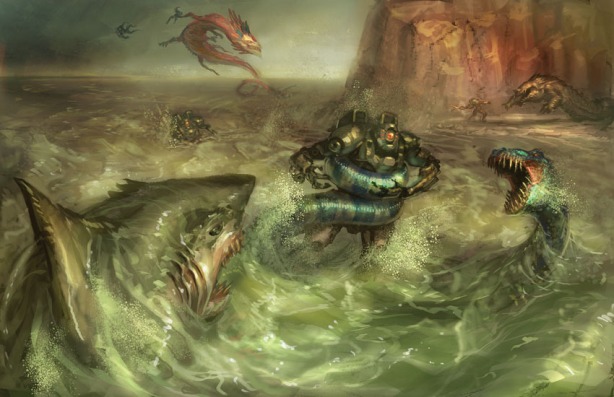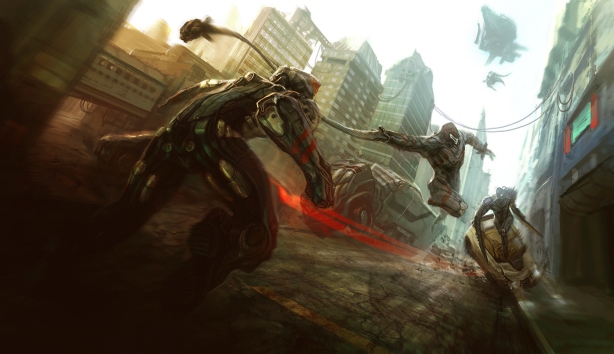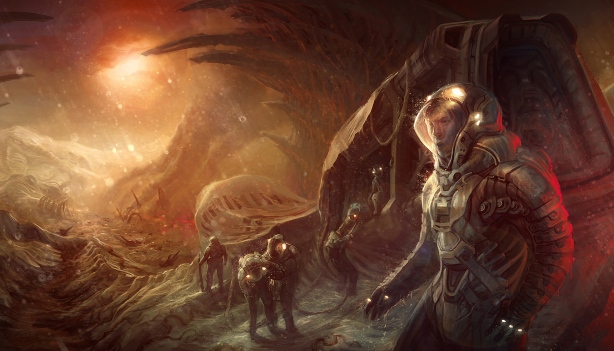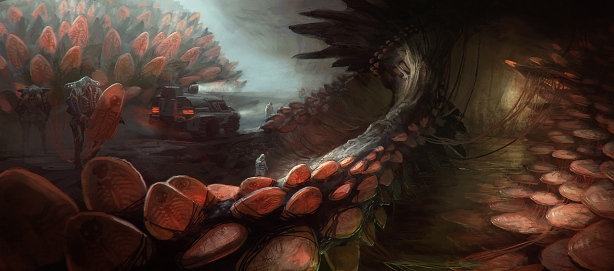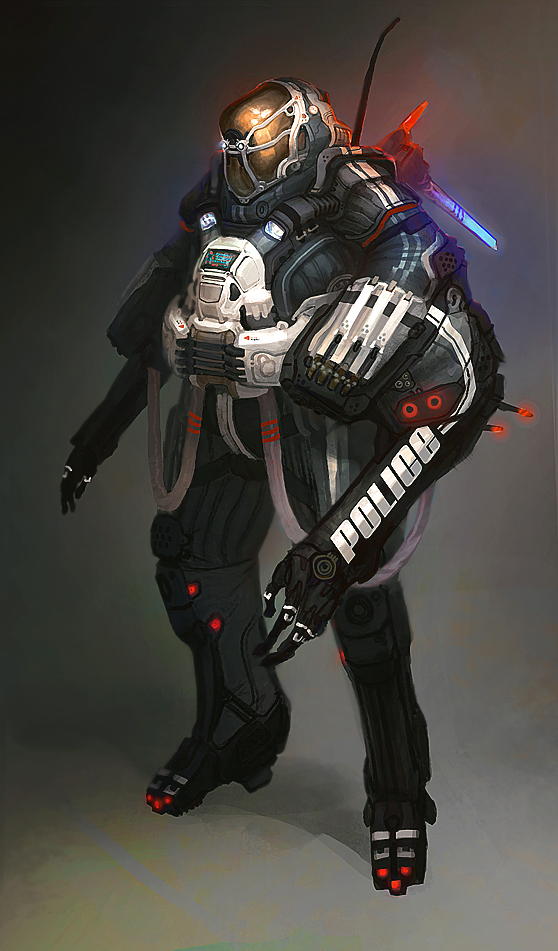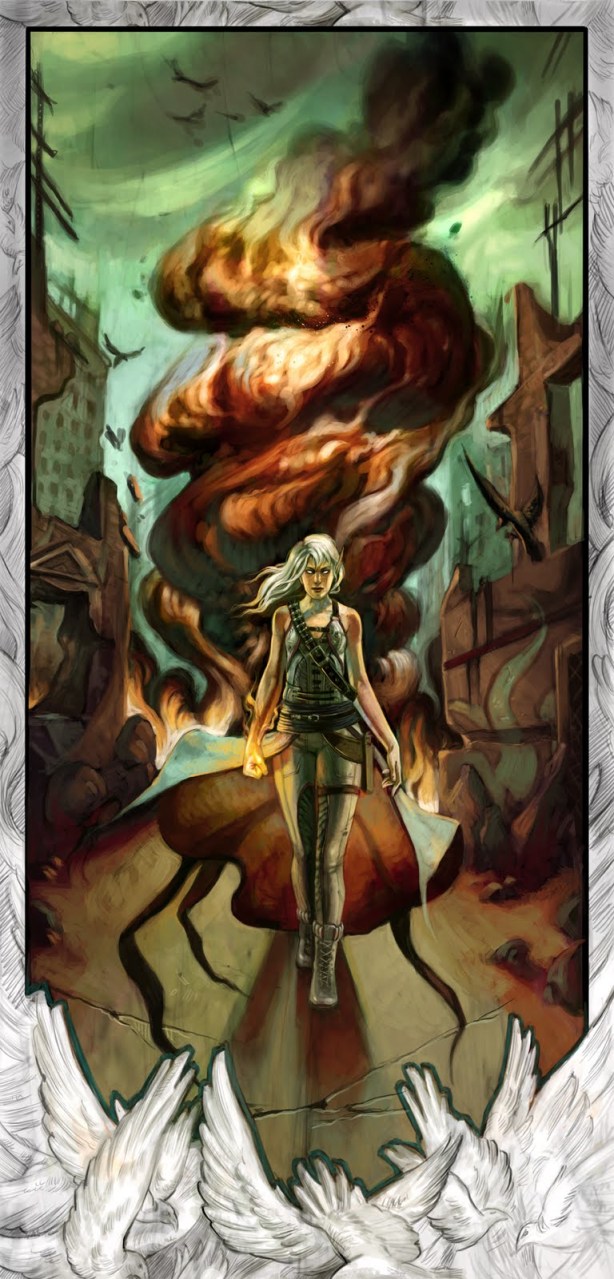Introduction:
What do I do?
Many of you are probably asking yourself, who the heck is this guy? My name is Mike Vaillancourt and I’m the Art Director for WildFire llc (CthulhuTech, Chthonian Stars, Poo, Nuts) and Sandstorm productions. I’ve been working in the hobby games industry since 1997 in several different roles. My initial foray into the industry was as a Information Systems Technician building retail store gaming LAN’s and associated hardware for retail support for Wizards of the Coast. I also contributed to graphic design on the gaming LAN desktops. My first professional illustration work for an RPG called Brave New World in 1999. In 2002 I joined the US Navy. While on active duty, I helped form a company with fellow industry veterans to develop the award winning RPG CthulhuTech.
While working on CthulhuTech I contributed work as a freelancer working as a graphic designer, concept artist, illustrator, and art director for several clients. To name a few I have worked for Triad Toys, Catalyst Game Labs, Microsoft/Bungie/343, and Bucephalus Games
As an Art Director I’ve worked with over 200 artists in the last 5 years from both the continental US and at least 10 other countries. My regular stable of artists is around 30. The major obstacle for several of the freelancers I no longer work with is that they either work for or have moved on to full time positions in video games. Contacting them at the right time in their schedule is a bit tricky. In other cases some of the artists have non-compete clauses with their current employer that prevents them from contributing artwork to my (WildFire or Sandstorm) game lines. To give an example, those artists work for companies like 343, Blizzard, Microsoft, Bungie, CCP, Volition, EA, NC Soft, and Arena.net.
So what is the purpose of this lecture? When I was approached to give an hour long demonstration to students and professionals I racked my brain trying to figure out whether I wanted to do a demo on industrial/mechanical design, character design, or graphic design… then it dawned on me. The majority of the audience (at best guess) would be students. Demo’s are valuable but ultimately there are far more qualified (and faster) professionals out there on the internet that have already covered the basics. What I felt I could most contribute to is your future as a professional artist. Those 2 primary tools being your portfolio and how to conduct yourself once you’re employed.
With all that said, and with the show and tell over, let’s dive into building your portfolio.
What do you want to do?
The first question you need to ask yourself is, “What is the objective of this portfolio?” Who do you want to work for, what do you want to do for that employer? Don’t put together material to work in a subject matter that doesn’t appeal to you. If your passion is sci-fi, fill your portfolio with sci-fi work. I would never hire someone to do work on material they didn’t enjoy working on. If you’re a 3D person and love doing 3D, focus on the things you enjoy doing the best i.e. characters, props, vehicles, or environments. Don’t put together a portfolio catered to getting a job that isn’t your first choice.
Remember, strong textures can also save a weak model.
Building the portfolio: Image is Everything
A well presented portfolio will make a huge difference and will help you stand out. What do you mean by “Well presented?” Taking the time and effort to put together your work in a well presented format. Think of it like a beautiful art book (Spectrum, D’Artiste, etc.) If the book consisted of images on a page with no text you, as the reader, would be lost. Put together complimentary images on the same page or facing pages and label the work appropriately. Font choice and even a bit of graphic design to spice up pages will also add another level of flair. Don’t sell me just on your work, sell me on you. If your portfolio doesn’t show that you put some effort into it, think of what that says to a potential employer about the kind of work they’ll get from you.
What should I show?
Limit the work to your best pieces. If it’s not your favorite work, take it out of the portfolio. Get a 2nd opinion on all work from any professional friends you might have and even better, if you happen to know an Art Director, ask them, and your instructor. If you’re in school your instructors can be valuable resources, USE THEM!
The one thing to be mindful of is that all art directors are looking for different things in a portfolio. So the question you’re asking yourself now is, “If every art director wants something different, how do I know what to put in my portfolio?” There’s 2 ways to go about this.
- A best guess based on work that the art director has had a hand in during their career.
You may not always know who the art director is and may not get the one you want a review with every time. In this instance be mindful of the work that the company they work for posts online. That work, 9 times out of 10, is work that their Sr. AD’s have deemed as the best work from the line or the most iconic. So if you want to work on Dungeons and Dragons, do work that fits in with Dungeons and Dragons. If you want to work for Bioware and your portfolio is full of World of Warcraft style images you need to put some time into doing work specifically geared towards working with your favorite Bioware property.
- Contact an art director directly and ask them what they’re looking for in a portfolio. This will take allot of guess work out of it. The important thing to keep in mind is that they’re busy so be direct and thank them for their time if they respond.
FORMAT:
Turn offs
– 3 Ring binder with clear view pages and a bunch of work printed on a low quality printer on standard printer paper will immediately turn me off from working with you. Leather bound zippered portfolio’s where the zipper sticks, the portfolio is overflowing with work, the binding pops open involuntarily, etc.
I’ll still take the time to review your work and give you some constructive criticism but the odds of me giving you work are slim unless you have some absolutely amazing looking work. In that case I’d give you my card and tell you to e-mail me digital samples. In either case you’re off to a rough start if that’s what you’re coming to the table with.
– An overly pretty cover/case for a portfolio shouldn’t outshine your work. There are many ways to put together a solid portfolio utilizing POD resources online whether it be via Lulu (a little overpriced) to even loading well designed portfolio pages into a program like iPhoto and having a book printed through iPhoto’s POD facility. Even a rush job with spiral binding with a frosted cover done at Kinko’s for $15 is worth your time.
iPads and iPods
May be appropriate for showing work for animation but they are inappropriate formats to show an illustration/print portfolio on. Why?
– First off, you’re applying for a job where your work will be printed in some medium.
– Monitors can be deceiving unless you’re working with a professionally calibrated high end monitor.
– The size is worthless for showing larger pieces.
– If you throw a dozen images into an image viewing program that tells me that you don’t care about your presentation.
– If you know that you’re going to want to talk to an Art Director at a convention you’re attending and you don’t have time to go down to a kinko’s or use iPhoto to print a decently bound copy of your portfolio that tells me that you really don’t want the work.
Web portfolio’s:
I spend more time reviewing portfolio’s online than in any other format as do most art directors. Because of this, it’s important that your website is somewhat up to date (work from within the last year) and that your contact information is easy to find. There are several artists whose sites I’ve gone to and really wanted to work with but I couldn’t find their contact info. In some cases I’ve e-mailed the artists at their link for contact and never gotten a response.
On that note, make sure that your e-mails go to a place that you check regularly if you want work. You can miss out on exciting freelance opportunities by not updating that information. In addition, make sure that it’s easy to e-mail you. Getting creative with your e-mail address by putting in spaces between letters and making an AD do extra work cleaning up your e-mail address is inconveniencing. Some of the best jobs come to you, don’t shoot yourself in the foot by making it hard to get in contact with you.
If you’re not good at web design and you know someone who is, enlist their aid. If you don’t know anyone there are several resources you can find online to learn how to build a website or use a web template. A decent template with an easy to navigate interface is better than a poorly designed site with broken links, hard to navigate galleries, and ugly graphic design.
Keys to a good website:
– Clean and easy to navigate. Ditch tiny thumbnails that make it difficult for me to figure out what I’m looking at. A clearly organized site featuring concept art (characters, environments, creatures, ID/Props), Illustration (Commercial, Spot, Cover Art, etc.), Design (logo’s, branding, etc.) is far preferable to a mess of thumbnails or poorly organized work.
– The first image I see on your sight should be your best work and compel me to look at the rest of your work.
– In addition, tell me what you do. Art Director, Graphic Designer, Concept Artist, Illustrator, Animator, etc. A link to a resume is good. Make sure you credit any publishers if you have professional work in there. If I see a logo from a well known game company that will help ad some context to the job.
Blogs:
– Difficult to show a portfolio but great for sketches, recent work posting, etc. I love blogs because they allow me to keep tabs on an artist. They’re also a great networking tool.
Other things to avoid.
– Animated intro’s and other crazy animations slow down my review time.
– Music. I have iTunes running when I’m working, if I’m reviewing a portfolio and your website has music interrupting my music I’m not going to be happy. I hate interruptions in my rhythm.
– Pop ups or links to work that add extra clicks to my viewing experience w/the exception of a simple gallery viewer is just fine.
What do I look for in a portfolio?
The first is how well designed the portfolio is. If you’re not that great at graphic design but know someone who is, enlist their help. Much like w/websites, well designed portfolio will go a long way. After the initial impression of design I do a 10 second flip through and find the worst piece. After I’ve found that piece if I decide that I could live with that level of work I go back through the portfolio one more time to take mental note of my favorite work.
Concept art
– Strong design skills: Can be inspired by other existing art but the strongest design goes back a bit in history and takes cues from real world design. Silhouette is important but if something doesn’t make sense in the overall design, ditch it.
i.e. A sci-fi suit of armor can be inspired by hockey equipment, Space Suits, Motorcycle armor, medieval armor, etc. Mechanical objects should look like they could work even with a bit of hand wavium technology.
Illustration
– Composition, anatomy/perspective, design/emotion in characters, value, and color.
Composition: The most important part of an illustration. A strong composition can put you into the action, detach you from the subject and overwhelm you, and in all cases it should help you feel something.
– Anatomy/Perspective: The 2nd most important aspect of an illustration. “It’s my style” is no excuse for not knowing anatomy or perspective. Those are the 2 most important details that will kill your work.
– Design: In many cases for illustration you’ll have to come up with costumes, characters, and props on your own. There are style guides and some reference to work from but it would be insane to try and concept hundreds of different costumes for a setting and have them available for an illustrator. I generally send out style guides or inspirational reference.
In every illustration the old adage “The bitch is in the details” couldn’t be more true. A well thought out piece that the artist obviously had fun with is going to stand out. If your design skills are weak and you want to be an illustrator you should spend more time on concept design. Building a strong image reference library is incredibly important. My image library clocks in at over 100 gigs of low res jpgs. Google images is your friend.
Reference is insanely important to successful illustration. No one can draw everything from memory and have it be believable.
i.e. If you’re going to design a sci-fi tank it’s good to look at actual tanks. Find out how they work, why they work, and then dive into design.
Here are a few great places to check out for tutorials and inspiration
– conceptart.org
– cghub
– thegnomonworkshop.com
Things You Shouldn’t Say/Do during a portfolio review
– “This isn’t my best work but…”
– “I just found out about these reviews so I quickly threw this together to give you a decent idea of my work.”
– “Sorry I’m all out of business cards.”
– If you have leave behinds as the AD if they would like said material. I can’t tell you how many stacks of post cards, business cards, or flyers/sell sheets I get from artists at convention that get round filed.
– Don’t argue with constructive criticism or feedback.
Good things to have for a portfolio Review
– A way to take notes based on feedback you’ve gotten.
– Plenty of business cards or a leave behind for the person doing the review in case they request it.
– Questions to ask the reviewer.
Closing: Questions AD’s have after the review
“How long did this piece take?” “What was this done for? Was it an assignment or a personal project for fun, speed paint or did you have nothing in particular in mind?” Knowing the details of a piece will help me better determine what kind of work I can give you.
When it comes to time frame, be honest. If the piece took you 3 days to do with breaks in between, tell them that. Don’t tell them that you did a piece in 8 hrs. when it was actually 2 hrs a day over 4 days.
Knowing your working habits helps them gauge what work to give you. If you say it takes 8 hrs and you’re available all month for freelance they might give you 12 pieces assigned to you. That scenario WILL kill you. Odds are, you’ll turn in work late and it will be sub par work at that, and they wont want to work with you again.
You Got the Job:
Do:
- Respect the Art Directors time. They’re busy people.
- Be clear in your communication and ask pointed questions.
- Let your AD know if there are any issues IMMEDIATELY. Don’t put it off until the last minute.
- Stay in communication with your AD at least twice a week during a job.
- Follow Instructions: If an AD sends you a document on instructions, follow them. Before you ask questions about your contract, review the documentation before sending the message. In many instances documentation has already answered your question. This also comes back to being respectful of the AD’s time.
- Be receptive to feedback, they’re paying you. Disrespecting the clients demands can have some nasty consequences. There is a right and a wrong way to debate whether a change is in the best interest of the client.
- Deliver on time.
- Turn in your paperwork if you want to get paid.
Don’t:
- Call your AD outside of listed office hours unless approved in advance.
- Don’t leave threatening voice mail message on your AD’s home phone if you haven’t heard from him over the weekend. (true story)
- Drop off the face of the planet and not respond to e-mails.
- Wait until the last week of a job to bail on an assignment because another job came up that paid more.
- Don’t price yourself out of a job: Understand the market. The Graphic Artists Guild Handbook: Pricing and Ethical Guidelines does not cover all levels of freelance. There may be some room for negotiation with rates but understand that a small client may not pay as much however, it could lead to much bigger jobs in the future.
- Don’t tick off the AD doing any of the above. They may know the AD that handles your dream property.
One Last but Extremely Important Note:
This industry is incestuous. Art Directors talk to one another. If an AD had a pleasurable experience working with you they’ll put in a good word for you with other AD’s. If they had a less than pleasurable experience and another AD sees that you worked with someone they know. They will generally ask them what they thought about working with you.
In the freelance world you don’t fall under the standard employee limitations of what can and cannot be said about your experience with that individual. Ultimately some AD’s may work well with certain artists better than others. In either case, being flexible is an important part of being a professional. Some AD’s will allow you to do whatever you want with a piece, others will require very specific things.
Another AD site to check out:
Art Order http://artorder.blogspot.com/ (Jon Schindehette) Sr. AD for Dungeons & Dragons (Wizards of the Coast)
